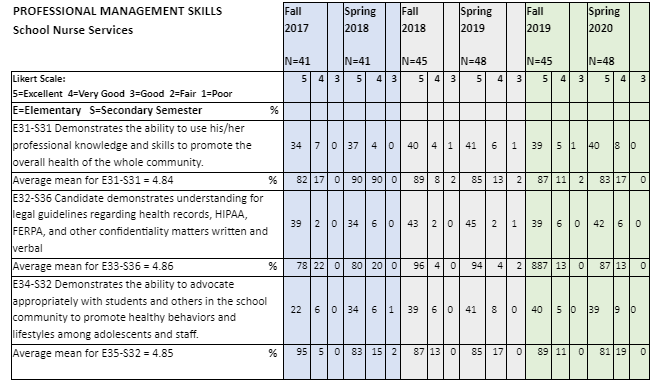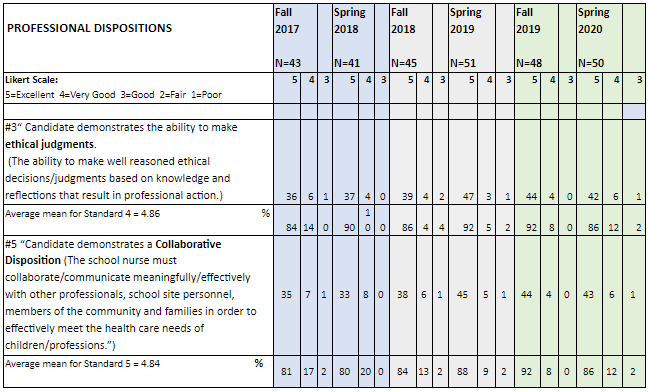AAQEP Accreditation
Standard 1 Aspect E
Standard 1. Evidence shows that by the time of the program completion, candidates exhibit knowledge, skills, and abilities of professional educators appropriate to their target credential or degree, including: Creation and Development of positive learning and working environments. (Safe schools, immunizations, Special Education, Individualized Health Care plans).
Data Sources & Analysis:
A healthy environment includes an atmosphere where the surroundings are physically, psychologically and emotionally healthy for all who inhabit the school. This can include exercise, hygiene and student wellness as well as larger environmental issues such as Covid-19, air pollution/asthma, and disaster preparedness. Activities that the school nurse might utilize include teaching CPR, First aid and other health related topics like bloodborne pathogens and collaborating with school site staff to institute suicide prevention and intervention, substance use disorder and campus violence programs to promote a safe environment.
DATA sources to be introduced:
- Preceptor Checklist of Skills and Competencies-Professional Management (Form P106/P206)
- Professional Dispositions (Form P104/204)
- Nursing 184: Practicum-Key Assignment: (Individualized Healthcare Plans or Action Plans)
Data Source 1
Midterm and Final Semester Fieldwork Evaluation, Preceptor Checklist of Skills and
Competencies-Professional Management Skills (Form P106/206)
The first measure is the Fall semester (Elementary) and Spring final semester (Secondary)
fieldwork evaluation Preceptor Checklist of Skills and Competencies-Professional Management
(P106/206) used by preceptors to evaluate candidates in their fieldwork knowledge
at two points.
Perspective: Preceptor
Elements Using:
- Item 1: E31-S31 Candidate “Demonstrates the ability to use his/her professional knowledge and skills to promote the overall health of the whole community.” Example skills from the preceptor checklist: E20 through E23, S19, S29.
- Item 2: E34-S32 Candidate “Demonstrates the ability to advocate appropriately with students and others in the school community to promote healthy behaviors and lifestyles among adolescents and staff.” . This includes collaboration with school staff to mitigate bullying, gang involvement and participation in crisis intervention strategies. Example skills from the preceptor checklist: E8, E9, E10 and S6, S7.
- Item 3: E32-S36 Candidate “Demonstrates understanding of legal guidelines regarding health records, HIPAA, FERPA, and other confidentiality matters written and verbal.” Example skills from the preceptor checklist: E38.
Definition of Success:
Candidates are rated on a 5-point Likert scale from a 5 rated as “Excellent” to 1
representing “Poor”. Our goal is all candidates will achieve an Excellent or Very
Good rating.

Summary of Findings
From 2017 to 2020:
- E31 and S31 scores on the Professional Management indicators demonstrated 99% of candidates
achieved an Excellent or Very Good rating demonstrating candidates had the ability
to assess the needs of students, staff and families in the provision of a positive
learning and working environment.
Three students received a Good rating and zero percent of students received a Fair or Poor rating. - E32-S36 scores on the Professional Management indicators demonstrated that 98% of candidates achieved an Excellent or Very Good rating demonstrating candidates had the knowledge and ability to understand legal guidelines needed for student safe environments. One student received a Good rating and zero percent of candidates received a Fair or Poor rating.
- E34-S32 scores on the Professional Management indicators demonstrated that 98% of
candidates achieved an Excellent or Very Good rating demonstrating that candidates
had the knowledge and ability to act appropriately with students and others to promote
healthy behaviors leading to a positive environment. One student received a Good rating.
Zero percent of the candidates received a Fair or Poor rating.
- Mean scores in E31-S31 ranged from 4.82 to 4.90 with an average of 4.84.
- Mean scores in E32-S36 ranged from 4.87 to 4.91 with an average of 4.86.
- Mean scores in E34-S32 ranged from 4.80 to 4.91 with an average of 4.85.
Analysis and Interpretation
The Professional Management indicator items provide evidence that preceptors rate
candidates with high marks overall in the ability to use professional knowledge and
skill to promote the overall health of the school community, advocate appropriately
with students and others to promote healthy behaviors and that candidates understand
the laws and regulations under which the school nurse practice is governed to provide
a safe and positive working environment.
Data Source 2
Professional Dispositions (P104/204)
The second measure is used by practicum preceptors to measure candidates' dispositions.
This is a 5-point Likert scale. The Professional Dispositions form states, “Please
circle on the scale the best number that best reflects the most accurate description
of student application of dispositions.”
Rationale for Using:
Professional Dispositions measures behavior needed for successful practice.
Elements of Data Source Using:
Items chosen to be assessed for “safe environments” are:
- Item #3: “Candidate demonstrates the ability to make Ethical Judgements.
(The ability to make well reasoned ethical decisions/judgments based on knowledge and reflections that result in professional action.) - Item #5: “Candidate demonstrates a Collaborative Disposition (The school nurse must collaborate/communicate meaningfully/effectively with other professionals, school site personnel, members of the community and families in order to effectively meet the health care needs of children/professions.)”
Definition of Success:
This measure is a 5-point Likert scale with Excellent to Poor ratings. Our goal is
100% of the candidates will measure an Excellent or Very Good on Dispositions.

Summary of Findings
From 2017-2020:
The Professional Dispositions Standard 3 shows that 99% of candidates were rated as
Excellent or Very Good in demonstrating behaviors that make ethical judgements. Four
candidates received a Good rating and zero percent of candidates received a Fair
or Poor rating.
Mean scores for Standard 3 ranged from 4.81 to 4.93 with an overall mean average of
4.86.
The Professional Dispositions Standard 5 shows that 97% of candidates were rated as
Excellent or Very Good in demonstrating behaviors that demonstrate collaboration.
Four candidates received a Good rating and zero percent of candidates received a Fair
or Poor rating.
Mean scores for Standard 5 ranged from 4.79 to 4.91 with an overall mean average of
4.84.
Analysis and Interpretation
The Professional Dispositions Standard 4 and 5 received high marks with 99% of candidates
receiving Excellent or Very Good on the ability to make Ethical judgements. In addition,
97% of candidates received Excellent or Very Good on Standard 5 showing the ability
to collaborate with school personnel, members of the community and families to effectively
meet the health care needs in a psychologically and physically safe environment.
Data Source 3
Grades from courses focusing on creation and development of positive learning and working environments. Nursing 184 Key Assignments: (Individualized Healthcare Plans).
Safe School Environments are an essential component of school nurse services credential coursework as demonstrated by areas of study including health office environment, confidentiality in record keeping, counseling and health status, immunization compliance, emergency planning, staff training in health areas and individualized health care plans.
Perspective: Program Faculty
Rationale for Using:
An Individualized Healthcare Plan (IHP) is “a plan of care written by the school nurse
for students who are at risk for physical or mental health needs” (National Association
of School Nurses, NASN). The IHP provides legal documentation of a standard for safe
care of students. This plan has input from the student, family and often the medical
provider. The IHP may be part of a Special Education Assessment or stand alone. The
IHP sets priorities, determines the necessary health care needs for a student to attend
school, such as medication administration or specialized procedures and includes actions
to be taken in an emergency.
Candidates in the program write an IHP as part of the Cross Cultural Special Education Case Study, as part of Special Education assessments, 504 Plans and when researching chronic health conditions. The goal is for candidates to achieve an 80% or “B” average in Nursing 184. Examples of N184 Research Questions include:
- Jimmy, age 8, is brought into the nurse’s office by his mother who states that he has an extreme allergy to peanuts. As a school nurse, what steps will you take to keep Jimmy safe? Who will you notify? What safety measures will you put in place? Relate this to a nursing theory/model and standard(s) of school nursing practice. Attach an Emergency Action Plan. Comment on the impact food allergies have on school nursing practice.
- Tommy is a 10-year-old wheelchair dependent paraplegic with a history of a spinal cord injury. He is transferring into a 5th grade class from out of district. He has a history of resource specialist services. There are orders for clean self-catheterization at school. Discuss the school nurse role, the initial steps to assist with personal needs, need for other possible services, paperwork, and reports for an upcoming IEP meeting. Develop an IHP (Individual Healthcare Plan) related to catheterization needs.
Candidate Mean GPA in CSUF School Nurse Services Credential Courses 2017-2020
| Mean GPA | 2017 | 2018 | 2019 | Mean GPA Combined |
|---|---|---|---|---|
| N136 Health Appraisal |
4.00 n=35 |
3.97 n=37 |
4.00 n=32 |
3.99 |
| N137 Teach Strategies |
3.86 n=35 |
3.89 n=45 |
3.89 n=35 |
3.88 |
| N184 SN Seminar I Elementary |
3.71 n=47 |
3.79 n=52 |
3.92 n=48 |
3.08 |
| N186 SN Practicum-Elementary |
3.83 n=47 |
3.84 n=51 |
3.94 n=49 |
3.87 |
| N185 SN Seminar II Secondary |
3.83 n=45 |
3.84 n=52 |
3.94 n=48 |
3.87 |
| N187 Practicum II Secondary |
3.93 n=44 |
3.88 n=51 |
3.94 n=50 |
3.91 |
Analysis and Interpretation
Candidate scores in all SNSC courses are high with combined means between 3.08 and
3.99 which suggest mastery in the ability to design and maintain safe positive learning
environments.
Analysis of Standard 1e Findings
Program Instructors and preceptors have the opportunity to evaluate SNSC candidates
in their ability to create and develop positive learning and working environments with examples as evidenced by professional management skills ratings, professional
dispositions and candidate GPA. Candidates understand legal guidelines regarding
health records, HIPPA, FERPA, and other confidentiality matters written and verbal.
Other areas embedded in SNSC coursework include provision of a safe, effective, confidential
health office for the provision of health and wellness. Individualized health care
plans provide a safe environment for provision of medication and specialized procedure
training and monitoring. Overall, candidates achieved high ratings in all SNSC coursework
demonstrating the ability to use professional knowledge and skills to promote the
overall health of the whole community.